
Variscite Gemstone: Properties, Meanings, Value & More
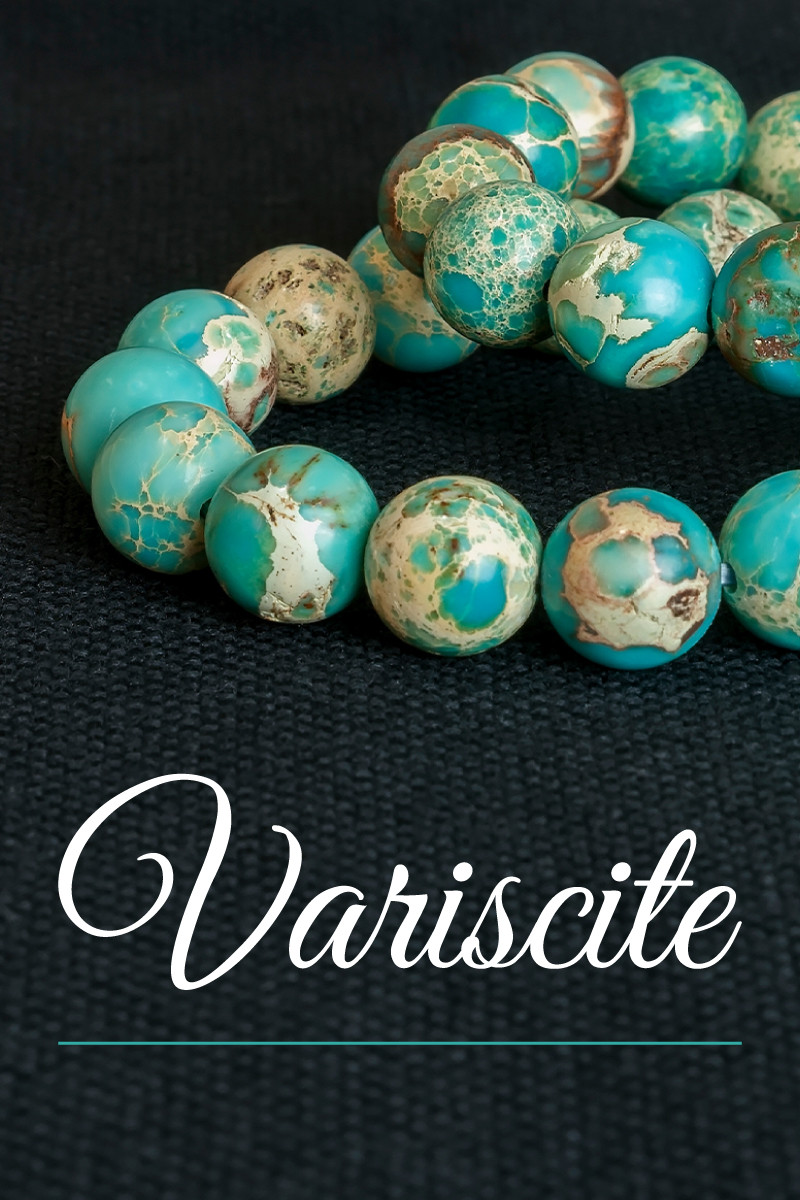 Variscite is a little-known, intense green gemstone with white or black patterns. The stone is somewhat fragile, so carvings and decor are more common than jewelry.
Variscite is a little-known, intense green gemstone with white or black patterns. The stone is somewhat fragile, so carvings and decor are more common than jewelry.
Is variscite a rare stone? Well-formed crystals are rare, but variscite’s massive aggregate form is more common.
Because it’s obscure, you’re more likely to see variscite for sale at trade shows or specialty gemstone sites than mainstream jewelry stores. Luckily, we have a wide variety of variscite gemstones available here at Gem Rock Auctions!
If you have questions about variscite gemstones before you shop, we’ll answer them all today! This guide will teach you all the variscite properties, benefits, prices, and more!
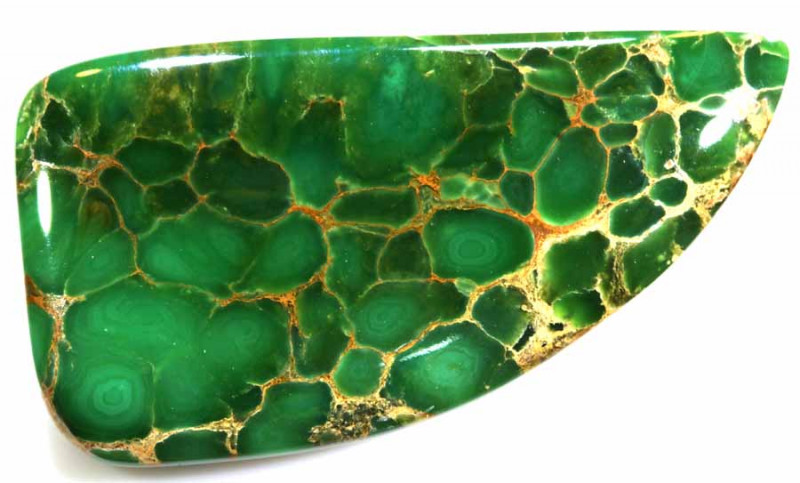
What Is Variscite Stone?
Variscite is a beautifully colored semi-precious gemstone of many names. Stones with color banding may go by “trainite” or “sabilite,” and “variquoise” recently became common for bluer variscite. Other monikers include:
Utahlite
Amatrice/Amatrix
Bolivarite
Peganite
These gems aren’t birthstones, but winter babies can substitute them for the traditional turquoise December birthstone. Celebrating an anniversary soon? You can also substitute variscite as the traditional 11th wedding anniversary gemstone!
Astrologically, variscite is a zodiac stone for Taurus, Gemini, and Scorpio.
Variscite Specifications & Characteristics
Variscite is a singular stone in the eponymous “variscite” mineral group. It’s a hydrated aluminum phosphate with a fairly low ranking on the Mohs mineral hardness scale of 3.5-4.5. Sometimes, chalcedony impurities can make variscite stones harder.
The stone is almost always opaque. However, some stones have translucent edges. Transparent variscite is very rare. Only Utah’s variscite is fluorescent.
The remaining variscite properties are:
Color: Typically shades of green, including yellow-green and blue-green, with black, brown, or white patterns; May be brownish-yellow or yellow-brown; Rarely red or violet
Crystal structure: Orthorhombic
Luster: Vitreous (crystals); Waxy to dull (masses)
Transparency: Translucent to opaque
Refractive index: 1.56-1.59
Density: 2.20-2.57
Cleavage: Good on [010] (crystals); None (masses)
Fracture: Conchoidal (crystals); Splintery or uneven (masses)
Streak: White
Luminescence: Fluorescence in specimens from some localities; Green in SW-UV & Whitish-green in LW-UV
We mentioned the variscite mineral group, so what varieties are there?
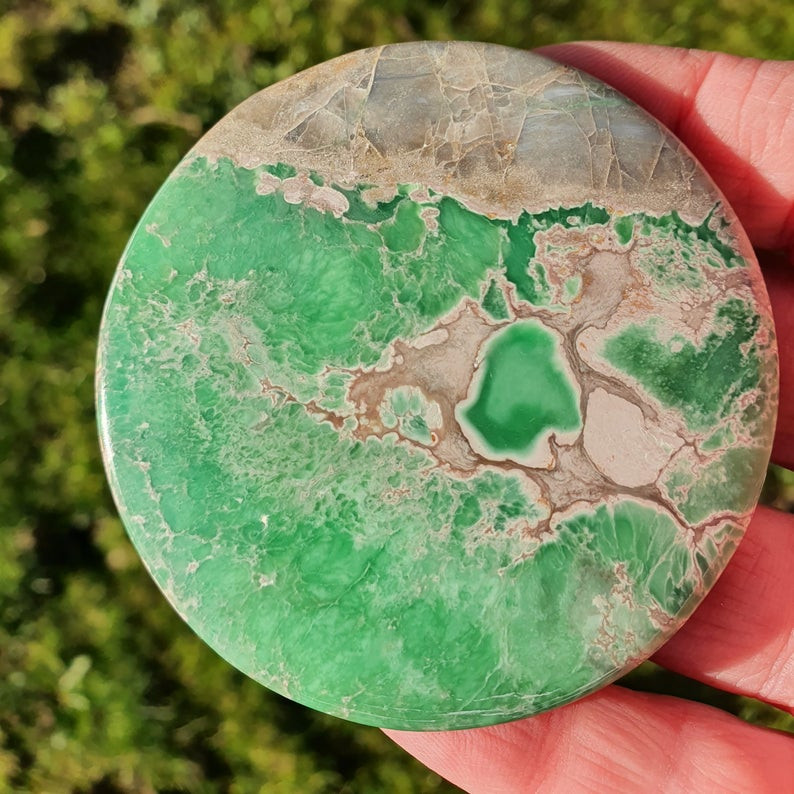 Image: Utah variscite
Image: Utah variscite
Types of Variscite & Similar Gems
The official variscite varieties are scorodite and mansfieldite, so we’ll cover those first:
Scorodite: Most common variety besides variscite, has beautifully colorful properties, but its fragility and arsenic content make it better for display than jewelry.
Mansfieldite: Very rare white to light gray variety (sometimes pink from cobalt) found in microscopic sizes.
Another variscite is impression jasper. Despite the name, impression jasper isn’t jasper but a multi-colored variscite. Vanadium and chromium create green portions, while iron blends in violet or red.
Now, what is Utah variscite?
Utah, USA, produces the highest-quality variscite called Utahlite. Most are light green with white veining, but some are deep emerald-colored. Utah variscite also has mesmerizing color patterns.
Utahlite nodules can reach 24 inches — yoga-mat width! The best material comes from the Little Green Monster Mine.
Variscite vs. Turquoise
By appearances, you may wonder: is variscite a turquoise? No, but they’re commonly confused.
Variscite vs. Turquoise: Both have the same composition, but turquoise adds in copper. Plus, variscite is rarer and softer.
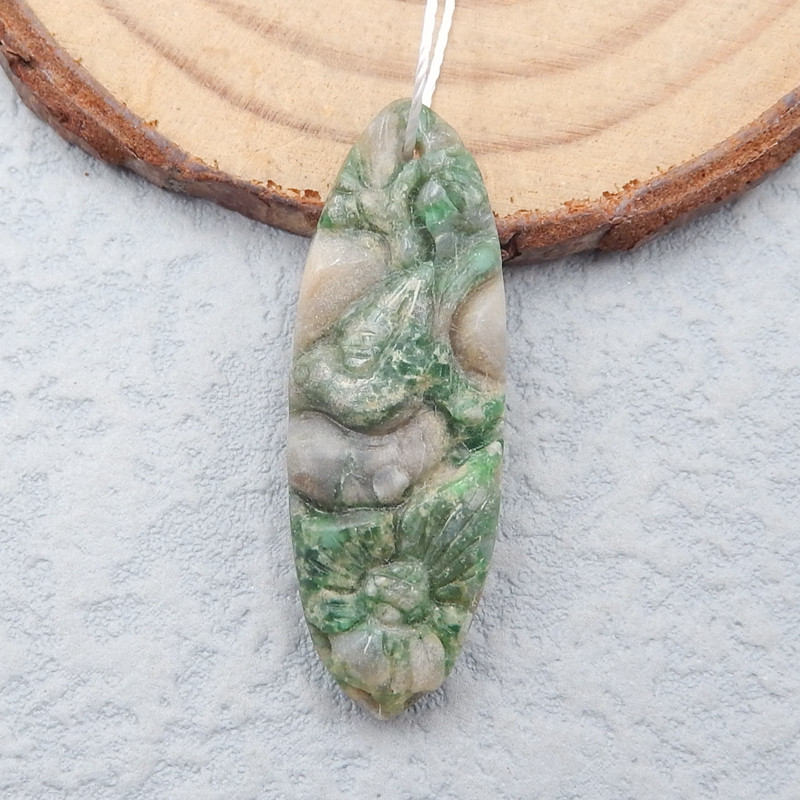
Variscite Meaning & History
This green gem possesses a few metaphysical meanings. Variscite’s spiritual meaning often ties to encouragement, joy, and unconditional love. It also symbolizes prosperity, balance, and connection.
Ancient History
Long before the modern discovery of variscite, people living over 6,000 years ago made variscite jewelry.
Later, people discovered these Neolithic artifacts in France and named them callaïs (“callainite” in English) based on a description of a similar gem from ancient Roman naturalist Pliny the Elder.
Initially, the French thought the beads were Chinese turquoise, though this was quickly refuted. Researchers believe the beads came from Italy, making them possible evidence of a European network of gemstone trading in prehistoric times.
Plus, these particular variscites still go by callaïs among historical and archeological circles.
Modern History
The name “variscite” comes from Variscia, the ancient name for Germany’s Voigtland district. This area is where variscite was first officially discovered, though the name came later.
German mineralogist Johann August Friedrich Breithaupt discovered a stone he named “peganite” in Saxony, Germany in 1830. In another part of Saxony, Briethaupt discovered a stone in 1837 and named it “variscite.” Later on, he realized both stones were variscite.
Similar instances (finding a stone, naming it, and realizing it was variscite later) occurred in many places. In 1865, French mineralogist Alexis Damour found variscite in a Celtic grave but called it “callainite.” In Spain, variscite was “bolivarite.”
The first Utah variscite discovery happened in 1893, technically by Frank Butt (who’d claimed the mine with his brother). Butt gave the variscite to F.T. Millis, who helped popularize the stone by sending it to a Smithsonian curator.
Trade names popped up from the Utah mine’s different owners. Don Maguire called it “utahlite” in 1904, and E.R. Valinski dubbed it “Amatrice” (for “American matrix”) in 1909. Waldemar Schaller called the Utah material from Lucin “lucinite” in 1916.
Shifting to spiritual uses, what is variscite stone good for?

Variscite Healing Properties
All gems can be healing stones, and green gemstones like variscite bring abundant benefits like grounding, attracting wealth, and promoting vitality.
Below, we’ll look at the specific variscite stone benefits for physical, emotional, and chakra healing!
Physical Healing
Some purported physical benefits of variscite include treating various abdominal issues like cramps, indigestion, and distension. It may also make your skin more elastic (fewer wrinkles) and encourage blood circulation.
Spiritual practitioners believe variscite can use your DNA and nervous system to project you into the astral realm, allowing you to explore past lives.
Emotional Healing
Emotional variscite benefits can include decreasing stress or anxiety. It’s also said to encourage tolerance and unity among people with different viewpoints — something we could all use nowadays!
Chakra Healing
Chakra healing opens an energy center (chakra) to relieve negative symptoms of a blockage. What chakra is variscite best for opening? The heart!
Your heart chakra governs love and adapting to change. When it’s blocked, you may feel resentful or numb. Using variscite as a chakra stone, you can replace those feelings with compassion, forgiveness, and vulnerability.

Variscite Gemstone Properties
The properties relevant to determining variscite’s objective value are its color, cut, carat weight, and if it’s synthetic or natural.
Color
Most variscites are green, usually in multiple shades. They’re often yellow-green, mint, or emerald-green. The green comes from chromium and vanadium.
White or black patterns are common, usually from crandalite or phosphate mineral inclusions. Other colors may come from element impurities, like the rare violet and red hues caused by iron.
The color pattern varies, including veins, webbing, splotches, and orbs among others.
The most sought-after variscite colors are black-spider-web Nevada variscite and emerald-green Utah variscite.
Cut
Variscite isn’t suited to faceted cuts, but cabochons, spheres, or intricate variscite carvings make beautiful jewelry or decor. The lack of cleavage in variscite masses make them even more durable cabochons.
Carat Weight
The size range for variscite is pretty broad. Many gems come in 20-carat sizes or larger, perfect for statement jewelry! Scorodites, however, only come in sizes under five carats.
Treatments, Synthetics, and Simulants
Variscite is only treated by jewelers trying to sell it as a turquoise simulant, often dyeing the stone closer to turquoise’s color.
Both synthetics and simulants of variscite have been around for decades. Sellers should always disclose this information.
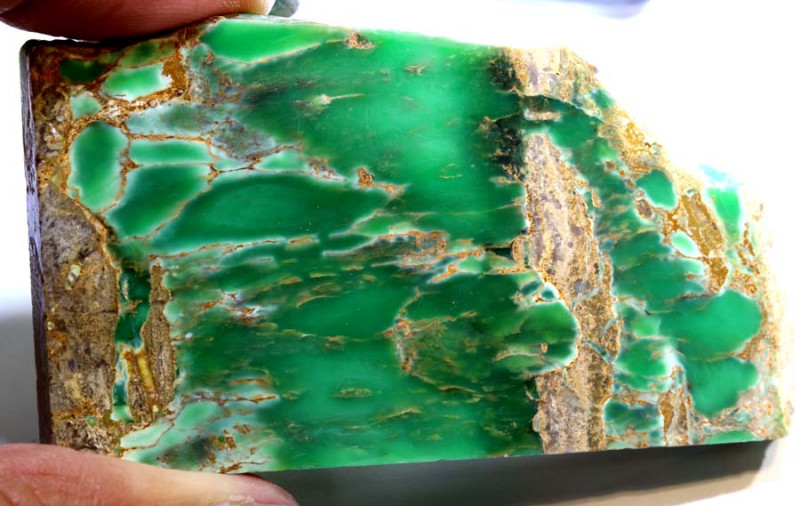
Variscite Formation & Sources
Variscite is a secondary mineral, meaning it starts as a different mineral but environmental forces on the host rock transform it into variscite.
In this case, the specific rock is usually aluminum-rich rocks like brecciated sandstone. The main force is water containing phosphate. The phosphate water reacts with the aluminous rocks, depositing the elements. These elements (along with weathering like oxidation) alter some minerals already in the rock into variscite.
Mining Locations
This stone is rare but widespread because a lot of variscite, raw, is tiny! Currently, the most significant locale is Utah, USA.
Other abundant variscite locales include:
Australia
Austria
Brazil
China
Czechia
France
Germany
Poland
Russia
Spain
Sweden
USA (Arizona, Arkansas, Nevada)
Scorodite rough most notably comes from Namibia, Mexico, Brazil, and the USA.
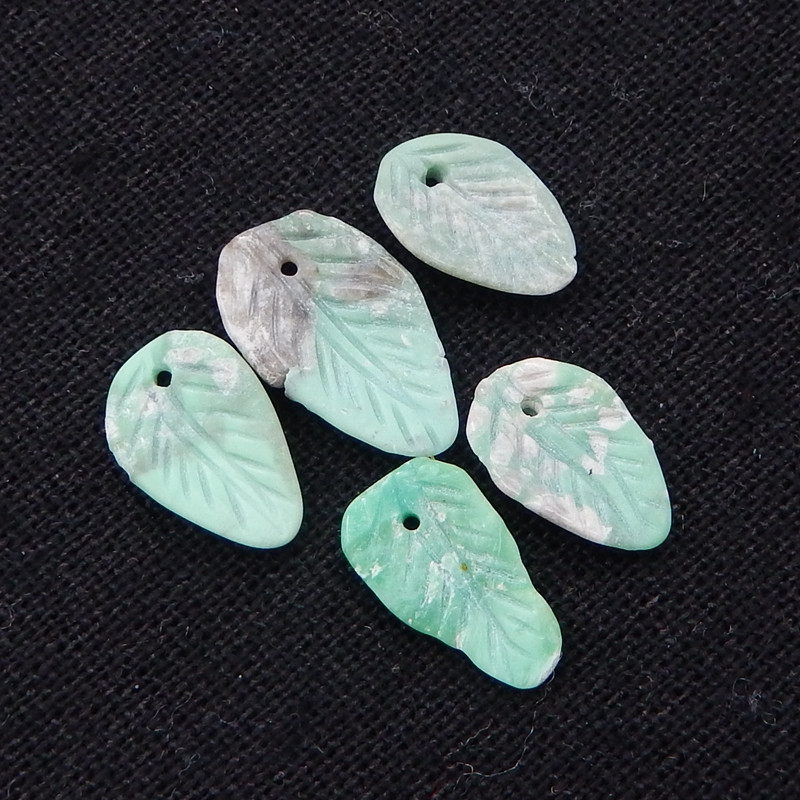
Variscite Stone Price & Value
Variscite’s value mostly depends on its shape, color, and size. Luckily, the stone’s lack of popularity makes it pretty affordable!
Cabochons at wholesale range from $0.30-$2 per carat when they’re paler, smaller, dominated by black inclusions, or all three. The price range increases to $18-$60 per carat for heavier cabochons with emerald-green coloring and more attractive patterns like golden-yellow veining.
Rough variscite price per gram for rough material is $0.03-$0.60 per gram.
Jewelry prices are higher but more variable. Beaded variscite bracelets or necklaces are usually $14-$70. Earrings have a broader range, from around $10 to near $300.
Pendants range from $30-$200, though designer options can exceed $700. Similarly, designer variscite rings can be near $1,000 but most are $20-$150.
Variscite Care and Maintenance
Knowing how to care for gemstones like variscite can keep it shining and intact. Variscite scratches easily, so we recommend opting for jewelry with protective settings. Rings are most vulnerable, while pendants, earrings, and brooches are safest.
Scorodite contains arsenic that’s toxic if inhaled, which can happen with scratches. Therefore, we recommend scorodite only for display, not jewelry.
You can safely clean variscite by dipping a soft, dust-free cloth into lukewarm water mixed with mild detergent, then gently wiping the stone. Rinse all soap residue from the stone, then let it air-dry.
Don’t leave variscite under strong heat for long periods, or it may have irreversible color damage.
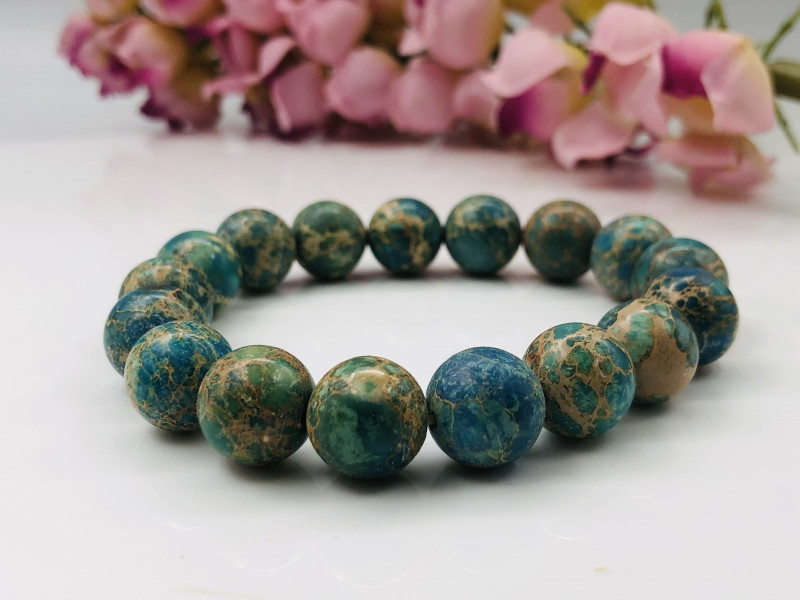
Enticed by Variscite’s Vibrance?
There are lots of green gems out there, including variscite’s doppelganger turquoise. But variscite’s obscurity gives it an eccentric, unique nature that few are lucky enough to know about – including you now!
If you’re seeking an ancient gem with one-of-a-kind patterns and abilities, look no further than variscite.
Search the Gemstone Encyclopedia
Related Auctions
Related Articles
Originally the Birthstones or gemstones were associated with a zodiac sign or the month of a individuals birth. Find out what your stone is and view the stones we have for sale
8th Feb 2021
There are dozens of quartz and chalcedony gems with various colors and patterns. Learn all about quartz properties and every type of quartz, from amethyst and agate to plasma and phantom quartz!
15th Oct 2020
Hackmanite is a pink to violet sodalite gem known for its unique color-change and luminescence. Learn why hackmanite is special, from its rare qualities to the types of hackmanite jewelry available.
28th Mar 2018
Latest Articles
Yugawaralite is a rare colorless, white, or pinkish zeolite crystal named for its discovery in Yugawara, Japan. Here we uncover the multifaceted history, properties, prices, and uses of yugawaralite.
24th Mar 2025
Simpsonite is a lesser-known mineral known on the gem market for its durability, yellow-orange color, and rarity. Discover all the properties, uses, prices, and history of simpsonite.
3rd Mar 2025
Kurnakovite is a colorless crystal related to inderite and rarely faceted but known among collectors. Explore the mineral traits, history, prices, and more in this kurnakovite guide.
17th Feb 2025
Article Categories
How To's is where you will find helpful articles from gem Rock Auctions on how to cut gemstones, select gemstones and buy gemstones.
9 Articles





